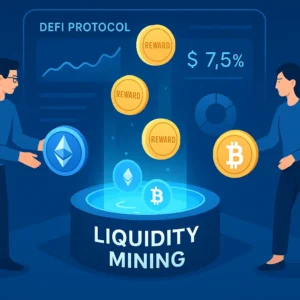Liquidity mining is a DeFi strategy that lets users earn rewards by depositing their crypto into decentralized exchange liquidity pools. These pools power token swaps without intermediaries, and contributors—called liquidity providers—receive a share of trading fees and bonus tokens in return. It’s a simple way to generate passive income while supporting decentralized markets.
What Is Liquidity Mining?
Liquidity mining is a decentralized investment strategy where users deposit crypto assets into liquidity pools on decentralized exchanges (DEXs) and receive rewards in return. These rewards typically come from:
- Trading fees paid by users who swap tokens on the platform.
- Bonus tokens provided by the protocol as incentives.
This process allows anyone to become a liquidity provider (LP) and earn income by helping the DeFi ecosystem function smoothly.
Liquidity Mining in a Nutshell
- You supply two or more tokens to a liquidity pool (e.g., ETH/USDC).
- You receive LP tokens, which represent your share of the pool.
- As others trade against the pool, you earn a portion of the trading fees.
- Some platforms offer extra rewards for staking LP tokens (also called DeFi smart mining).
Liquidity Mining vs Traditional Crypto Mining
| Feature | Liquidity Mining | Traditional Mining (e.g., Bitcoin) |
| Role | Provide tokens to a liquidity pool | Validate transactions by solving math problems |
| Infrastructure Needed | Just a wallet and tokens | Expensive hardware and electricity |
| Income Type | Fees + token incentives | Block rewards |
| Network Type | DeFi (Decentralized Finance) | Blockchain consensus layer |
Who Are Liquidity Providers (LPs)?
Liquidity providers are users who:
- Deposit tokens into DeFi platforms like Uniswap, Curve, or Balancer.
- In return, receive LP tokens to track their share.
- Can later withdraw their original assets plus any earned rewards.
Without liquidity providers, decentralized exchanges would lack the trading volume and speed users expect — making LPs essential to the DeFi ecosystem.
Liquidity Mining in Crypto
Decentralized finance (DeFi) is transforming how people invest, trade, and earn income in the crypto space. One of its most popular innovations is liquidity mining — a method that allows users to earn rewards by supplying assets to decentralized platforms.
Liquidity mining is the process of contributing cryptocurrencies to a liquidity pool on a decentralized exchange (DEX) in return for a share of the trading fees and token incentives.
This mechanism plays a crucial role in keeping decentralized markets fluid and functional.
Key Highlights
- Earn passive income by providing liquidity to DeFi protocols.
- Support decentralized trading by enabling token swaps without centralized intermediaries.
- Receive additional rewards, including governance tokens and platform incentives.
Why It Matters
| Benefit | Description |
| Passive income potential | Users earn a share of trading fees and incentive tokens. |
| Supports DeFi ecosystems | Helps decentralized exchanges function without centralized control. |
| Low barrier to entry | Anyone with a crypto wallet and tokens can participate. |
In the following sections, we’ll break down how liquidity mining works, the platforms involved, the risks to consider, and how it compares to other DeFi earning strategies like staking and yield farming.
How Liquidity Mining Works
Liquidity mining allows crypto users to earn passive rewards by providing token liquidity to decentralized exchanges (DEXs). Here’s how the process works, from start to finish:
Step-by-Step Guide
- Choose a DeFi Platform
Start by selecting a reputable decentralized exchange that supports liquidity mining. Popular choices include:
- Uniswap (Ethereum-based)
- PancakeSwap (Binance Smart Chain)
- Curve Finance (Stablecoin-focused)
- Balancer (Flexible pool configurations)
When choosing a platform, consider factors like total value locked (TVL), supported tokens, platform reputation, and available reward programs.
- Provide Tokens to a Liquidity Pool
Each pool consists of a pair (or basket) of tokens used for trading on the exchange. To become a liquidity provider (LP), you’ll need to:
- Deposit equal values of two tokens (e.g., 50% ETH + 50% USDC).
- Some platforms support single-sided staking or auto-balancing mechanisms.
Example: If ETH is $2,000 and USDC is $1, you could deposit 1 ETH + 2,000 USDC into the ETH/USDC pool.
- Receive LP Tokens
After depositing, the platform issues Liquidity Provider (LP) tokens. These tokens represent your share of the pool and act as a claim to:
- Your deposited assets
- Any trading fees or rewards earned while your liquidity is active
You can redeem these LP tokens later to withdraw your original tokens plus accumulated earnings (minus any losses, such as impermanent loss).
- Earn Fees and Rewards
As traders use the pool to swap tokens, you earn a share of the trading fees — typically 0.3% per trade on Uniswap.
Many platforms also offer extra rewards in the form of native or governance tokens. These incentives are distributed proportionally based on your pool share and are part of what makes liquidity mining profitable.
Bonus: DeFi Smart Mining (LP Token Staking)
Some platforms allow or require you to stake your LP tokens in a separate reward contract to earn additional incentives — this is sometimes called:
- DeFi smart mining
- Dual staking
- Yield farming with LP tokens
This extra step can boost your returns but may also add complexity and risk, especially if smart contracts are unaudited or vulnerable.
What Does Locked Liquidity Mean in Crypto?
Locked liquidity refers to a mechanism where the assets in a liquidity pool are made unremovable for a specific period using a smart contract. This is often done by DeFi projects to build investor trust and prevent rug pulls.
What Is Locked Liquidity?
When a project launches a new token, it typically creates a trading pair (e.g., TOKEN/ETH) and adds it to a decentralized exchange. To avoid early exit scams, the project can lock the liquidity it provides to the pool by sending LP tokens to a time-locked smart contract.
| Term | Explanation |
| Liquidity Pool | A smart contract holding tokens to enable trading on a DEX |
| LP Tokens | Proof of your share in a liquidity pool |
| Liquidity Lock | A mechanism that restricts LP tokens from being withdrawn for a set period |
Why Locked Liquidity Matters
Locked liquidity serves as a security signal to the community. It shows that the project creators can’t suddenly withdraw all the liquidity and vanish — a practice known as a rug pull.
Key benefits of locked liquidity:
- Investor Confidence: Shows commitment and discourages exit scams.
- Price Stability: Prevents sudden liquidity removals that could crash the token price.
- Transparent Launches: Reassures early buyers that liquidity is not easily manipulated.
How Liquidity Is Locked
Projects typically use third-party tools like:
- Unicrypt
Team Finance - PinkLock
These platforms offer verifiable and transparent locking services with public smart contract data, so anyone can check how long the liquidity is locked.
Real-World Example
A new token might lock its $500,000 in LP tokens for 12 months. This means that even the team cannot access or remove the liquidity during that time, reducing investor risk and increasing credibility.
Locked liquidity is a critical safeguard in DeFi, especially for newly launched tokens. Without it, investors are exposed to high levels of trust-based risk — something the decentralized world is trying to minimize.
DeFi Mining vs. Yield Farming vs. Staking
Though often used interchangeably, liquidity mining, yield farming, and staking are distinct strategies within the DeFi ecosystem. Each offers ways to earn passive income from crypto, but they differ in purpose, risk, and how rewards are generated.
| Strategy | How It Works | What You Earn | Assets Involved |
| Liquidity Mining | Provide token pairs to a DEX liquidity pool | Trading fees + bonus tokens | Two tokens (e.g., ETH/USDC) |
| Yield Farming | Move funds across DeFi protocols to chase the highest APY | Platform tokens, rewards, governance rights | LP tokens or single assets |
| Staking | Lock tokens in a network to help validate blocks (Proof-of-Stake blockchains) | Block rewards or fixed yield | One token (e.g., ETH, ADA) |
Liquidity Mining
Liquidity mining is perhaps the most accessible entry point into DeFi income strategies. It involves supplying two tokens to a liquidity pool on a decentralized exchange, such as Uniswap or Curve. For example, you might contribute equal values of ETH and USDC into an ETH/USDC pool. In return, the platform issues you liquidity provider (LP) tokens, which track your share of the pool. As other users swap tokens through the pool, you earn a share of the trading fees based on your contribution. Some platforms also offer additional token rewards, making this strategy both straightforward and potentially profitable for those looking to support decentralized exchange ecosystems.
Best for:
- Supporting DEX ecosystems.
- Earning passive rewards while contributing to market liquidity.
Yield Farming
Yield farming builds upon the concept of liquidity mining but takes a more aggressive and flexible approach. Instead of simply holding LP tokens, users move them—or other crypto assets—between multiple platforms to maximize returns. This strategy often includes staking LP tokens on third-party platforms that offer additional rewards, such as governance tokens. Yield farming requires more active management and a deeper understanding of DeFi protocols, but it can result in significantly higher returns. However, the complexity also brings added risks, including smart contract vulnerabilities and exposure to volatile or unverified pools.
Best for:
- Advanced users who can monitor and manage positions regularly.
- Earning platform-native or governance tokens.
Staking
In contrast, staking is a simpler and more conservative method tied to the operation of blockchain networks themselves. With staking, users lock up a single token—such as ETH, ADA, or SOL—to support the consensus process on Proof-of-Stake (PoS) blockchains. By helping validate transactions and maintain network security, stakers earn rewards in the form of additional tokens. Unlike liquidity mining or yield farming, staking does not involve trading pairs or pools, making it easier to understand and manage. It is often preferred by long-term holders who seek steady returns without constant monitoring.
Best for:
- Long-term holders of Proof-of-Stake assets.
- Lower-maintenance, lower-risk income generation.
Each strategy offers a different risk-reward profile. Liquidity mining offers a balanced and relatively passive experience, yield farming caters to more advanced users seeking higher gains, and staking provides stability and simplicity for those committed to specific networks. Choosing the right one depends on your technical knowledge, risk tolerance, and investment goals.
Key Differences at a Glance
| Feature | Liquidity Mining | Yield Farming | Staking |
| Passive or Active | Mostly passive | Active | Passive |
| Asset Risk | Impermanent loss | Smart contract + IL risk | Network slashing (rare) |
| Lock-in Period | Varies | Varies | Often fixed or flexible |
| Technical Skill Needed | Basic | Intermediate to advanced | Basic |
Understanding these differences helps you choose the right strategy for your goals — whether it’s long-term network participation, agile profit-seeking, or simply putting idle crypto to productive use in a DEX pool.
Risks of Liquidity Mining
While liquidity mining can be rewarding, it’s not without risk. Understanding these risks is essential before committing your funds to a liquidity pool. Below are the key factors that can affect your returns and even lead to potential losses.
1. Impermanent Loss
One of the most common and misunderstood risks is impermanent loss. This occurs when the price of the tokens you’ve deposited into a pool changes significantly compared to when you entered. As the pool automatically rebalances the token ratio, you may end up with fewer of the more valuable asset. If you withdraw at the wrong time, your total holdings could be worth less than if you had simply held the original tokens.
Example:
| Scenario | Outcome |
| Token A rises sharply in value | Pool sells some Token A to maintain balance → you hold less of it |
| Token B drops in value | Pool increases your exposure to Token B |
While fees earned may offset some of the loss, they don’t always fully cover it — especially during volatile market swings.
2. Smart Contract Vulnerabilities
Liquidity pools are managed by automated smart contracts. If those contracts have bugs or are poorly audited, they may be exploited by hackers. Funds locked in such pools can be stolen or frozen permanently.
Key risks include:
- Coding errors in liquidity contracts
- Flash loan attacks
- Protocol design flaws
Choosing well-established platforms with open-source, audited code (like Uniswap or Curve) can reduce this risk, but not eliminate it entirely.
3. Rug Pulls and Exit Scams
In less reputable or newer DeFi projects, developers may lock in liquidity to attract investors, then remove it or abandon the project — a scam known as a rug pull.
Warning signs of risky projects:
- No verified team or code audits
- Very high promised yields (often unrealistic)
- Limited community or developer transparency
4. Market Volatility
The overall volatility of crypto markets can affect both the tokens in your pool and the demand for trading. During bear markets or sharp crashes:
- The value of your deposited assets may decline
- Trading activity may drop, reducing fee rewards
5. Regulatory Uncertainty
Liquidity mining operates in a largely unregulated space. As governments begin to introduce crypto-related policies, there’s a chance some platforms or activities could become restricted or face legal scrutiny — especially in jurisdictions with stricter financial controls.
Summary of Risks
| Risk Type | Description |
| Impermanent Loss | Loss in value due to price divergence of pooled tokens |
| Smart Contract Risk | Bugs or exploits that can lead to stolen or frozen funds |
| Rug Pulls & Scams | Malicious project teams removing funds or shutting down suddenly |
| Market Volatility | Fluctuations that reduce both token value and pool trading activity |
| Regulatory Risk | Legal uncertainty depending on jurisdiction and platform |
Being aware of these risks doesn’t mean you shouldn’t participate — but it does mean you should do proper research, choose reputable platforms, and understand your risk tolerance before diving in.
DeFi Mobile Mining & Accessibility
As DeFi evolves, liquidity mining is no longer limited to tech-savvy users with desktop wallets or advanced tools. Today, it’s increasingly accessible through mobile apps, allowing everyday users to participate in DeFi mining directly from their smartphones.
How Mobile Liquidity Mining Works
Modern crypto wallet apps now integrate DeFi protocols, making it possible to:
- Connect to decentralized exchanges (DEXs) like Uniswap, PancakeSwap, or SushiSwap.
- Supply liquidity to pools and receive LP tokens.
- Track rewards and pool performance in real time.
- Stake LP tokens within the same app (in platforms that support smart mining).
Popular Mobile Wallets That Support DeFi Mining
| Wallet/App | Features |
| MetaMask Mobile | Connects to any Ethereum-based DEX via in-app browser |
| Trust Wallet | Built-in DEX, staking, and liquidity pool access for BNB Chain tokens |
| Rainbow Wallet | Easy-to-use Ethereum wallet with DApp browser for DeFi integration |
| SafePal | Multi-chain support with built-in DeFi and yield farming dashboard |
These apps allow users to manage DeFi strategies on the go, with intuitive interfaces and secure private key storage.
Why Mobile Access Matters
- Lower barrier to entry: No need for complex setups or browser extensions.
- On-the-go management: Add, remove, or rebalance liquidity anytime, anywhere.
- DeFi for everyone: Expands participation beyond traditional crypto users and developers.
As mobile-first DeFi continues to grow, liquidity mining is becoming more user-friendly and inclusive, enabling a wider audience to benefit from decentralized finance without technical hurdles.
Tips for Getting Started with Liquidity Mining
Getting started with liquidity mining doesn’t require advanced technical skills — but taking the right steps early can help you avoid costly mistakes and maximize your returns.
Start with Reputable Platforms
Before depositing any assets, choose a well-known and trusted DeFi platform. Look for those with:
- High total value locked (TVL)
- Transparent teams and open-source code
- External smart contract audits
Examples:
Uniswap, Curve, PancakeSwap, Balancer, SushiSwap
Understand the Token Pair
Each liquidity pool requires two tokens, and you must deposit equal values of both. Before committing:
- Study how each token behaves (volatility, historical price range)
- Avoid pairing two highly volatile assets unless you’re comfortable with risk
- Be cautious with tokens that have low trading volume or limited use
Evaluate Impermanent Loss Potential
Ask yourself: What happens if one token’s price moves dramatically?
To reduce risk:
- Start with stablecoin pairs (e.g., USDC/DAI) to minimize price divergence
- Use impermanent loss calculators to estimate potential outcomes
Consider Starting Small
Test with a small amount first to get comfortable with:
- Adding/removing liquidity
Receiving and managing LP tokens - Monitoring fees and rewards
This helps you learn the process without exposing large amounts of capital to potential risks.
Diversify Across Pools
Instead of putting all your funds into one pair or platform, consider spreading your assets across:
- Multiple pools with different risk profiles
- Different blockchains (e.g., Ethereum, BNB Chain, Arbitrum)
Diversification helps reduce the impact of poor performance in any single pool.
Track Your Performance Regularly
Keep an eye on:
- Rewards earned
- Asset price changes
- Total pool value
- Any protocol updates or risks
Use tools like Zapper, DeBank, or the DeFi dashboards in your wallet to monitor your positions.
Secure Your Assets
- Use a non-custodial wallet with private key or seed phrase backup
- Avoid clicking on unknown links or connecting to suspicious DApps
- Enable app-lock or biometric security on mobile wallets
By taking a cautious and informed approach, you can participate in liquidity mining more confidently — and with better long-term outcomes.
Conclusion
Liquidity mining has become a cornerstone of decentralized finance, offering crypto holders a way to earn passive income while contributing to the health and functionality of DEX ecosystems. By supplying token pairs to liquidity pools, users help maintain the fluidity of decentralized markets and, in return, receive a share of the fees and incentives generated through trading activity.
Although the process is accessible and potentially profitable, it comes with its share of risks, including impermanent loss, smart contract vulnerabilities, and market volatility. That’s why understanding the mechanics, starting cautiously, and choosing reputable platforms is essential for long-term success.
As DeFi continues to grow, liquidity mining stands out as a practical entry point for those looking to engage with crypto beyond simple holding. When approached with care and knowledge, it can be both a rewarding investment strategy and a meaningful contribution to the decentralized future of finance.
34-year-old writer and content strategist with a passion for technology, culture, and storytelling. Over the past four years, he’s taken a strong interest in the crypto sphere, diving deep into blockchain trends, meme coin madness, and the evolving DeFi space.
0 comments
Related post
Table of content










